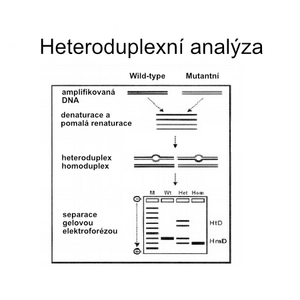Heteroduplex analysis
Heteroduplex analysis is a method of direct molecular genetic diagnosis related to DGGE. The analyzed sample is mixed with reference DNA, denatured and then allowed to hybridize again.
If the sequence of the reference DNA differs from the sample ( for example due to the presence of a mutation), in addition to the original homo duplexes, mixed molecules consisting of one strand from the sample and one from the reference DNA will be formed. Because such hetero duplexes contain a non-complementary stretch without hydrogen bonds, they will disintegrate significantly earlier during electrophoresis on a denaturing gel.
Another possibility is cleavage of heteroduplexes at the site of non-complementarity. This is possible chemically or, more reliably, enzymatically (e.g. T4 endonuclease VII or T7 endonuclease I).This approach is referred to as enzyme mismatch cleavage (EMC). It is reported to be 90% effective.
Currently, this type of analysis is partically no longer used and has been replaced by sequencing methods.

